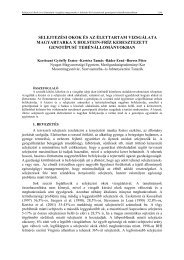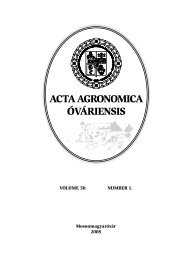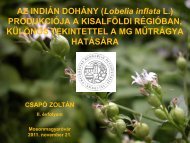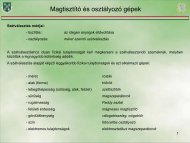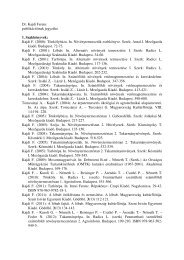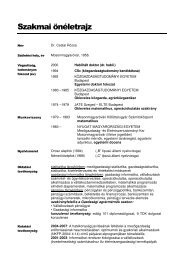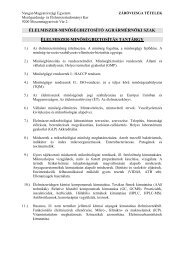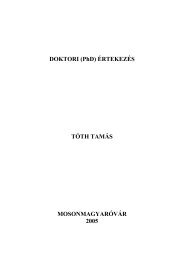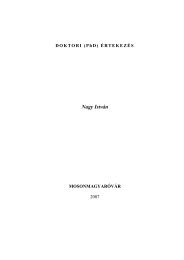teljes anyag - Nyugat-Magyarországi Egyetem Mezőgazdaság
teljes anyag - Nyugat-Magyarországi Egyetem Mezőgazdaság
teljes anyag - Nyugat-Magyarországi Egyetem Mezőgazdaság
Create successful ePaper yourself
Turn your PDF publications into a flip-book with our unique Google optimized e-Paper software.
The main issues of land consolidation in Hungary, with special regard...73The target of the voluntary exchange of lands with the purpose of integrating land propertiesis: the union into property-plots through the fusion of outskirt land. The fusion into oneproperty-plot is not a definite legal term, but it is important to establish unified property -plots,ever more of them. If unified property-plots are not created, then it will be an ordinary barter,one kind of trade. It is still not a property-plot, if the agricultural lands get closer to eachother, but still remain distant and scattered. In order to establish one or more property-plotsthe owners of the in-between areas have to be involved in the process. It is not necessary tobecome direct neighbours, but land consolidation would mean it in case of smaller areas.(If bigger areas get closer to each other, it could mean land consolidation.)The term property-plot (plot of land property) is not a legal, but an agronomical definition(category). The result of voluntary exchange of lands with the purpose of integrating landproperties is: the change(s) results directly in property-fusion.Unfortunately the Section 26 (1) paragraph of the Land Act – regulations of a separate Actare normative in case of the general land consolidation procedure – has not become actualas the mentioned rule has not been framed yet. That is why the possibility composed in the(2) paragraph is important, according to it until the land consolidation rule is not framedvoluntary exchange of lands can be initiated for land consolidation.Surveys carried out so far have shown that the voluntary exchange of lands does not fill itsprimary function, namely the aims of land consolidation, and serves mainly as evasion ofcharges due. Its reason can be traced back to the financial benefits of malpractice and thecostly land consolidation based on field change. (The voluntary exchange of lands is onone hand side accompanied with a significant lawyer fee, on the other hand the registry ofthe land forming, the (new) land property is rather cost worthy, too. The recited two itemscan cost the affected parties – together and pro hectares – approximately 15–20 thousandForints.) On the other hand it has to be seen that the numerous, atomized land owners donot posses any kind of self-organizing power or ability to enforce their interests. Mainlythe bigger land tenants are not interested in realization of land consolidation. That is whythe initiative role and the active participation of the MARD would be absolutely necessaryin the process.The quantification of speculative land change is because of ethical reasons is not possible. Itcan be concluded from the information gained from the registry of title deeds that this is theaim of the majority of the recorded land changes. This method helps to avoid the publicityof land trade and the legalisation of forestalling defined in the Land Act. Since the validatedmodification of the Land Act from August 1 2008 it is only possible to change land intoland, and the interests of the local person and the land consolidation has priority.The question of land consolidation – considering the legal possibilities regarding thevoluntary exchange of lands – has not moved from standstill since the birth of the LandAct 14 years ago. The question is raised why this has not occurred yet, although land consolidationis financially supported by the European Union agricultural policy. Concerningthis, the Council Regulation (EC) No. 1698/2005 of 20 September 2005 about the ruraldevelopment subsidies from the European Agricultural Found for Rural Development(EAFRD) is normative. Although the regulation (expressis verbis) doesn’t name this




